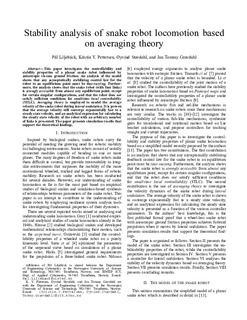| dc.contributor.author | Liljeback, Pål | |
| dc.contributor.author | Pettersen, Kristin Ytterstad | |
| dc.contributor.author | Stavdahl, Øyvind | |
| dc.contributor.author | Gravdahl, Jan Tommy | |
| dc.date.accessioned | 2017-02-13T13:27:28Z | |
| dc.date.available | 2017-02-13T13:27:28Z | |
| dc.date.created | 2012-02-15T15:54:24Z | |
| dc.date.issued | 2011 | |
| dc.identifier.citation | IEEE Conference on Decision and Control. Proceedings. 2011, 1977-1984. | nb_NO |
| dc.identifier.issn | 0743-1546 | |
| dc.identifier.uri | http://hdl.handle.net/11250/2430602 | |
| dc.description.abstract | This paper investigates the controllability and stability properties of a planar snake robot influenced by anisotropic viscous ground friction. An analysis of the model shows that any asymptotically stabilizing control law for the robot to an equilibrium point must be time-varying. Furthermore, the analysis shows that the snake robot (with four links) is strongly accessible from almost any equilibrium point, except for certain singular configurations, and that the robot does not satisfy sufficient conditions for small-time local controllability (STLC). Averaging theory is employed to model the average velocity of the snake robot during lateral undulation. It is proven that the average velocity will converge exponentially fast to a steady state velocity, and an analytical expression for calculating the steady state velocity of the robot with an arbitrary number of links is presented. The paper presents simulation results that support the theoretical findings. | |
| dc.language.iso | eng | nb_NO |
| dc.title | Stability analysis of snake robot locomotion based on averaging theory | nb_NO |
| dc.type | Journal article | nb_NO |
| dc.type | Peer reviewed | nb_NO |
| dc.source.pagenumber | 1977-1984 | nb_NO |
| dc.source.journal | I E E E Conference on Decision and Control. Proceedings | nb_NO |
| dc.identifier.doi | 10.1109/CDC.2010.5717822 | |
| dc.identifier.cristin | 909728 | |
| cristin.unitcode | 7401,90,23,0 | |
| cristin.unitname | Anvendt kybernetikk | |
| cristin.ispublished | true | |
| cristin.fulltext | postprint | |
| cristin.qualitycode | 1 | |
